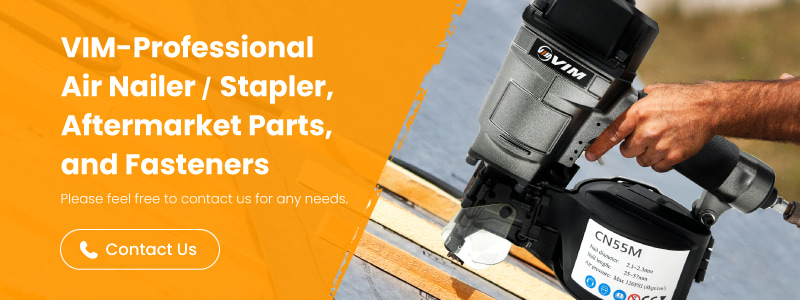V Nails or Cartridge Wedge? 5 Pro Tips for Perfect Fastener Selection
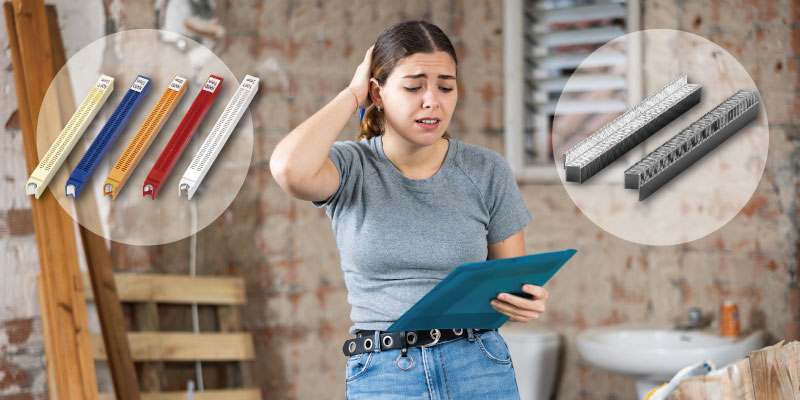
Do you know the frame wedge comes in two different types? One is the cartridge wedge, and the other is V nails. But what’s the actual difference between them—and how do you choose the most appropriate fastener for your machines and applications?
In the picture frame manufacturing and woodworking industries, choosing the right fastener plays a critical role in achieving clean, secure, and visually precise joints. Among the most widely used options are frame wedges, which are internal joining elements designed to pull mitered corners tightly together without visible surface damage.
In this article, we will introduce the fundamentals of the frame wedges, compare the features of V nails and cartridge wedges, explore common application scenarios, and offer practical advice to help you select the right fastener for your specific production needs.
What is Frame Wedge?
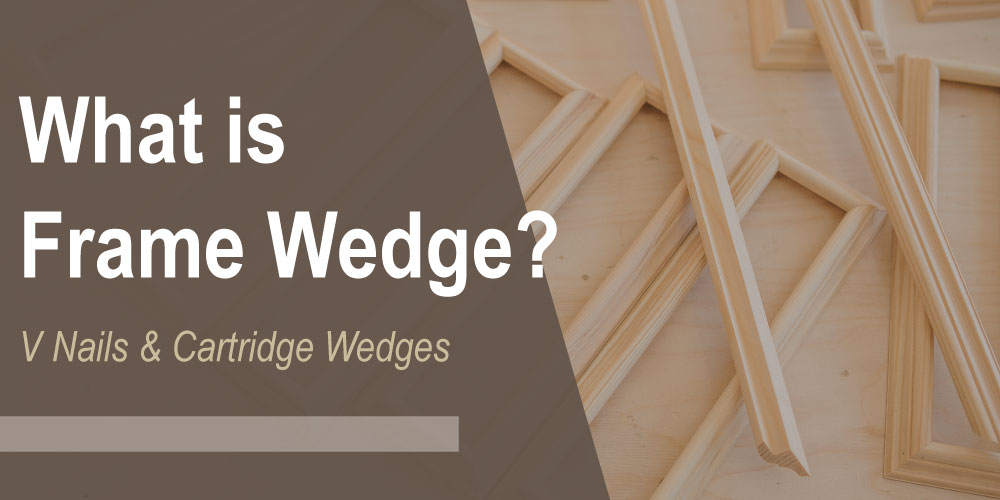 The term Frame Wedge refers to a specialized category of fastener used primarily in picture frame assembly and woodworking joints. It encompasses two main types: V Nails and Cartridge Wedges-both engineered to draw frame pieces tightly together from the underside. V nails, typically supplied in strips, are loaded into manual or pneumatic frame nailers for sequential firing. Cartridge wedges, on the other hand, are pre-stacked in magazine style cartridges for use with fully automatic underpinners. While each format serves different levels of production volume and automation, both share the same core function-delivering secure and accurate corner joints.
The term Frame Wedge refers to a specialized category of fastener used primarily in picture frame assembly and woodworking joints. It encompasses two main types: V Nails and Cartridge Wedges-both engineered to draw frame pieces tightly together from the underside. V nails, typically supplied in strips, are loaded into manual or pneumatic frame nailers for sequential firing. Cartridge wedges, on the other hand, are pre-stacked in magazine style cartridges for use with fully automatic underpinners. While each format serves different levels of production volume and automation, both share the same core function-delivering secure and accurate corner joints.
【Extended reading: Don't Miss These Insider Tips: How to Assemble Picture Frames with Frame Wedge Nailers】
Different Types of Frame Wedge
 In the frame assembly industry, selecting the right frame wedge is critical to achieving strong, gap-free miter joints. There are two primary types of fasteners commonly used for this purpose: Cartridge Wedges and V Nails. Each type is engineered to meet different production environments, machine compatibility, and workflow demands. Understanding the distinction between these two formats allows manufacturers and framers to optimize efficiency and ensure consistent joint quality.
In the frame assembly industry, selecting the right frame wedge is critical to achieving strong, gap-free miter joints. There are two primary types of fasteners commonly used for this purpose: Cartridge Wedges and V Nails. Each type is engineered to meet different production environments, machine compatibility, and workflow demands. Understanding the distinction between these two formats allows manufacturers and framers to optimize efficiency and ensure consistent joint quality.
Cartridge Wedge
A cartridge wedge is a collated fastener enclosed in a rigid shell, specifically engineered for fully automated underpinners, such as those produced by Cassese. These frame wedges are available in both soft and hard types, catering to various frame materials from softwood to dense hardwood. The standard crown width of cartridge wedges is 10.3 mm, and they are manufactured in multiple lengths-5 mm, 7 mm, 10 mm, 12 mm, and 15 mm-to accommodate different frame depths.
【Related product: Cartridge Wedge for Hardwood and Softwood】
V Nails
V nails are the most commonly used frame wedge in both manual and pneumatic joiners. Unlike cartridge wedges, V nails are not enclosed in a shell but are supplied in collated strips for efficient machine feeding. They are available in both soft and hard types to accommodate a wide range of wood densities.
Two main standards exist in the market: the UNI type, with a 10.3 mm crown, and the AL type, featuring a slightly wider 10.7 mm crown. Certain underpinner brands—such as Alfa underpinners—are designed specifically to operate with the AL type V nails, making crown width compatibility a critical consideration when selecting the appropriate fastener. Both UNI and AL types are available in standard lengths of 5 mm, 7 mm, 10 mm, 12 mm, and 15 mm, offering flexibility across various framing depths and joint configurations.
【Related product: V-Nails for Hardwood and Softwood】
Cartridge Wedge vs. V Nails Comparison Table
| Feature | Cartridge Wedge | V Nails |
|---|---|---|
| Fastener Type | Enclosed in a rigid shell | No shell Supplied in collated strips |
| Nail Hardness | Soft & Hard types | Soft & Hard types |
| Crown Width | ‧ UNI type: 10.3 mm | ‧ UNI type: 10.3 mm ‧ AL type: 10.7 mm |
| Available Lengths | 5, 7, 10, 12, 15 mm | 5, 7, 10, 12, 15 mm |
| Machine Compatibility | ‧ Cassese underpinner | ‧ Most strip-fed joiners (Manual or Pneumatic) ‧ Alfa underpinner (Use AL type) |
Applications of Frame Wedge
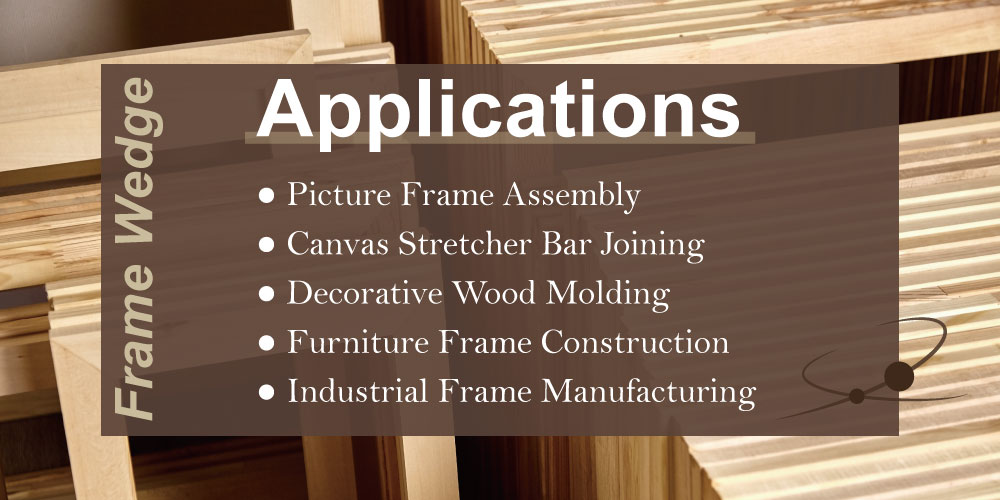 Frame wedges are highly specialized fasteners engineered for internal corner reinforcement in wood joinery, especially where aesthetic and structural precision are critical. Both V nails and cartridge wedges serve diverse framing needs-from custom shops to high-volume production. Below are the key applications where frame wedges deliver essential performance and efficiency.
Frame wedges are highly specialized fasteners engineered for internal corner reinforcement in wood joinery, especially where aesthetic and structural precision are critical. Both V nails and cartridge wedges serve diverse framing needs-from custom shops to high-volume production. Below are the key applications where frame wedges deliver essential performance and efficiency.
Picture Frame Assembly
The most common application of the frame wedge is in picture frame production. Whether using V nails in manual joiners or cartridge wedges in automated underpinners, these fasteners pull the mitered corners tightly together from underneath. This ensures perfectly aligned corners without any visible surface hardware, making them idea for gallery-quality frames, photo displays, and high-end retail products.
Canvas Stretcher Bar Joining
Artists and print manufacturers rely on frame wedges to assemble canvas stretcher bars. The precise penetration and clamping action of V nails help keep the wooden bars aligned and square under canvas tension. This application demands a fast, glue-free joining method that maintains frame shape over time.
Decorative Wood Molding
High-end wood molding and trim-such as those used in mirrors, wall art, or cabinetry-often require discreet, internal joining. Frame wedges provide an efficient solution that avoids glue stains or metal exposure on the visible surface.
Furniture Frame Construction
Certain lightweight furniture components use V nails as internal fasteners to reinforce corner joints during pre-assembly. This method is valued for its speed and clean finish in both prototyping and mass production stages.
Industrial Frame Manufacturing
In large-scale frame factories, selecting the right type of frame wedge is crucial for maintaining production speed and joint accuracy. Cartridge wedges are commonly used in fully automated underpinners—such as those from Cassese—where their shell-based design enables smooth feeding, minimal downtime, and high-throughput assembly. On the other hand, systems like Alfa underpinners are designed to operate with AL type V nails, which are collated strip-type fasteners offering similar speed and consistency, but without the cartridge shell. Whether using cartridge or strip-fed formats, automation-ready machines rely on precision-matched fasteners to deliver reliable, repeatable corner joints in industrial production environments.
How to Choose the Right Frame Wedge
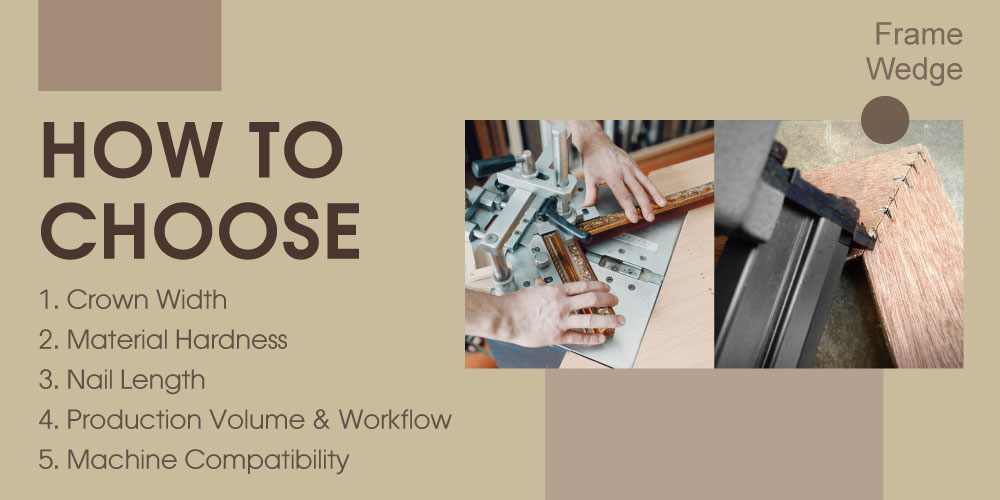 Selecting the right frame wedge is essential to achieving strong, accurate, and aesthetically clean joints in picture frame assembly. As a professional fastener supplier, we recommend evaluating several key factors to ensure optimal performance and compatibility with your production setup.
Selecting the right frame wedge is essential to achieving strong, accurate, and aesthetically clean joints in picture frame assembly. As a professional fastener supplier, we recommend evaluating several key factors to ensure optimal performance and compatibility with your production setup.
1. Crown Width
V nails are manufactured in two crown widths: UNI type (10.3 mm) and AL type (10.7 mm), Choosing the appropriate crown type based on your machine specification is critical to avoid jamming or misfiring during operation.
2. Material Hardness
Different wood types demand different nail hardness. Use soft V nails or cartridge wedges for lightweight or softwood frames (like pine), and hard types for hardwoods (like oak or maple). Matching the frame wedge hardness to the material prevents cracking, ensures tight joints, and extends tool life.
3. Nail Length
Select the nail length based on frame thickness. Standard lengths for both V nails and cartridge wedges include 5 mm, 7 mm, 10 mm, 12 mm, and 15 mm. Longer nails provide deeper penetration but must be matched carefully to the frame profile to avoid surface breakthrough.
4. Production Volume & Workflow
Both cartridge wedges and V nails are used in automated framing systems, depending on machine design. Cassese underpinners require cartridge wedges, while Alfa underpinners operate with AL type V nails. For flexible or small-batch production, V nails remain a practical and efficient fastener choice.
5. Machine Compatibility
Start by confirming the type of underpinner in use. Cassese underpinners require cartridge wedges with a shell-based design, while machines like Alfa underpinners are compatible with AL type V nails. Using the correct fastener format ensures proper feeding, firing accuracy, and reduced downtime.
Conclusion
Whether you are operating a custom framing workshop or a fully automated production line, selecting the right frame wedge-be it V nails or cartridge wedges-is essential for achieving clean, durable, and accurate frame joints. While cartridge wedges are shell-based fasteners used in automated machines like Cassese, V nails are strip-fed and compatible with manual, pneumatic, and automated systems, including Alfa underpinners. Each format serves different equipment types and production goals, making fastener selection a key part of overall framing performance.
At VIM, we supply both V nails and cartridge wedges in a full range of sizes, crown types, and hardness options—manufactured to meet the high standards of modern frame production. Whether you're working with softwoods, hardwoods, or specialized machinery, our fastener experts can help you make the right choice. If you’re still unsure which type of frame wedge best suits your application, VIM of fastener specialists is here to help. Contact us today for tailored product recommendations and technical support.
Article Classification
Recent Articles
- The 4 Carton Staples Issues Ruining Your Packaging—Solved in Minutes
- 5 Reasons Why VIM Concrete T Nails Deliver Unmatched Grip and Durability
- The Hidden Force in Every Staple: 9 Point Types That Make Fastening Last
- 8 Expert Facts on Strip Nails for Smarter Fastening Choices
- From Car Seats to Fences: 3 Points to Choose the Perfect Hog Ring Size

